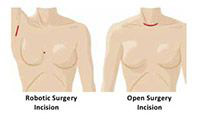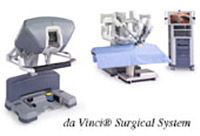Download the da Vinci Thyroidectomy brochure

Thyroid Surgery
Means of treating thyroid nodules, thyroid cancer, hyperthyroidism, or other diseases of the thyroid gland.
During this surgery part or all of the thyroid gland is removed.
Traditional approaches to thyroid surgery, both open and endoscopic, require an incision to be made at the base of the neck, resulting in a visible scar and possible damage to the nearby glands and nerves.
Parathyroid Surgery
Surgical removal (parathyroidectomy) of the hyperactive gland(s) is the only known cure for primary hyperparathyroidism and is currently the best treatment option.
Traditional approaches to parathyroid surgery, both open and endoscopic, require an incision to be made at the base of the neck, resulting in a visible scar and possible damage to the nearby glands and nerves.
Thyroid and Parathyroid Surgery Without a Neck Scar

Transaxillary robotic-assisted thyroid and parathyroid surgery utilizes the latest da Vinci® Si High Definition minimally invasive robotic surgical system to make a two inch incision below the armpit. This allows Dr. Kandil to maneuver a small camera and specially designed surgical and nerve monitoring instruments between the muscles of the neck to access the thyroid or parathyroid gland; diseased tissue can be removed through this incision, eliminating the prominent neck scar that is a byproduct of the traditional surgical approach, and reducing the risk of injury to the nearby glands and nerves.

The da Vinci® Si High Definition Minimally Invasive Robotic Surgical System allows for an enhanced view of the patient’s anatomy and greater surgical precision than the traditional open or endoscopic surgical method.
Why Robotic Assisted Surgery?
Dr. Emad Kandil of the Tulane Thyroid Center is the only endocrine surgeon in the country that is qualified to perform robotic-assisted thyroid and parathyroid surgery; he has successfully treated patients who were previously considered not to be candidates for this surgical approach.
- Incision is made under the arm.
- No visible scarring.
- Three-Dimensional enhanced high-definition with up to 10x magnification resulting in an enhanced view of patient anatomy.
- A field of vision that is superior to open or endoscopic surgery.
- Instrument dexterity and range of motion that is greater than the human hand.
- Dr. Kandil’s hand movements are scaled, filtered and seamlessly translated into precise movements using electromechanically enhanced instruments that relay feedback sensations from the operative field throughout the procedure.
- Some patients may not be a candidate for robotic-assisted surgery due to disease complications or health status.
